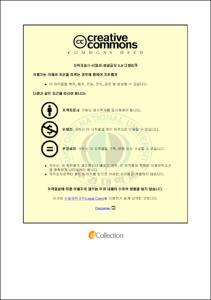도시환경디자인 향상을 위한 통합디자인 개념의 유형화
- Alternative Title
- Types of Integration Design Concept for Improvement of Urban Environment Design
- Abstract
- Modern-day cities place great value on the quality of life in the urban environment. Urban residents’ pursuit for a comfortable lifestyle and urban environment design for the city’s competitiveness have become increasingly important. However, the disharmony between the development of individual values and excessive expression has led to reduced visual impact. This study identifies communication issues between the elements of urban environment design that hinder design enhancement to suggest the principle of integrated design as a solution.
Precedent studies, literature reviews, guidelines and research reports were analyzed to extract and classify the elements and characteristics of urban environment design. Terminology and studies related to integrated design were examined to establish principles and select the main characteristics, and the Delphi technique was used to derive the following results.
(1) Primary elements of urban environment design were identified as open spaces, urban structures, street furniture and architectural aesthetics. Secondary elements were urban environment colors, nightscape and lighting which are factors that add to the primary elements.
(2) The characteristics of urban environment design elements were legibility, variability, openness, authenticity, publicness, functionality, versatility, simplicity, uniqueness, complexity, symbolism, identifiability, aesthetics, safety, connectivity, continuity, artistic value, flexibility, availability, awareness, accessibility, identity, plasticity, harmony, comfort, feasibility, consistency, transparency, convenience and environmental value.
(3) Integrated design refers to design in which several elements are organized for harmony and cohesion to create an entirety. It can be defined as design which completes an urban environment by organizing individual principles in a harmonious arrangement.
(4) There are 4 types of integrated design principles, classified as location-centric unification-oriented, location-centric differentiation-oriented, feature-centric unification-oriented and feature-centric differentiation-oriented.
This study aimed to fulfill the need for integrated design in which urban environment design elements communicate with each other to blend in harmony, and resolve the difficulties of managing the various elements through the types of integrated design. However there was no common ground between policy issues and systems, which restricted the possibility of application.
Many design guidelines are being prepared these days for designs ordered by public organizations. This means that overall theories and systematic planning techniques for integrated design should be studied and promoted.
- Issued Date
- 2011
- Awarded Date
- 2011. 2
- Type
- Dissertation
- Publisher
- 부경대학교
- Alternative Author(s)
- Jang, Myoung Jin
- Affiliation
- 부경대학교
- Department
- 대학원 건축공학과
- Advisor
- 김기환
- Table Of Contents
- Ⅰ. 서 론 1
1.1 연구 배경 및 목적 1
1.2 연구 방법 및 범위 3
1.3 선행 연구의 고찰 5
Ⅱ. 도시환경디자인에 대한 이론적 고찰 7
2.1 도시환경 패러다임의 변화 및 정비의 필요성 7
2.1.1 도시환경의 개념 및 범위 7
2.1.2 도시환경의 구성요소 8
2.1.3 도시환경 패러다임의 변화 9
2.1.4 도시환경의 기본목표와 방향 10
2.1.5 도시환경의 현황 및 문제점 12
2.2 도시환경디자인의 배경 및 방향 13
2.2.1 도시환경의 이미지 13
2.2.2 도시환경디자인의 개념 14
2.2.3 도시환경디자인의 필요성 15
2.2.4 도시환경디자인의 목적 16
2.2.5 도시환경디자인의 역할 17
2.3 델파이 기법(Delphi Technique) 18
2.3.1 델파이 기법의 개념 및 특성 18
2.3.2 델파이 기법의 의의 19
2.3.3 델파이 기법의 신뢰도와 타당성 19
2.3.4 델파이 기법의 장·단점 20
2.3.5 델파이 기법의 활용 22
Ⅲ. 도시환경디자인 요소 추출과 특성 분석 23
3.1 도시환경디자인 요소 추출 24
3.1.1 요소 범위 및 추출 방법 24
3.1.2 요소 추출 연구 대상 25
3.1.3 요소 선별 및 분류 기준 28
3.1.4 도시환경디자인 요소 추출 29
3.2 도시환경디자인 요소의 특성 30
3.2.1 오픈스페이스의 특성 30
3.2.2 도시구조물의 특성 32
3.2.3 가로시설물의 특성 34
3.2.4 건축물미관의 특성 39
3.2.5 도시환경 색채의 특성 41
3.2.6 야간경관 및 조명의 특성 43
3.2.7 도시환경디자인 요소 특성의 종합 45
Ⅳ. 통합디자인 개념의 유형 46
4.1 통합디자인의 개념 47
4.1.1 어휘의 의미 고찰 47
4.1.2 통합디자인의 정의 및 목적 49
4.1.3 통합디자인의 역할 및 효과 49
4.2 통합디자인 개념의 유형화 과정 50
4.2.1 통합디자인 개념의 유형화 의의 50
4.2.2 델파이 기법 조사 개요 51
4.2.3 델파이 기법 조사 과정 및 결과 53
4.3 통합디자인 개념의 유형별 효과 및 방향 64
4.3.1 포지셔닝 맵(Positioning Map) 64
4.3.2 통합디자인 개념의 유형별 효과 및 활용 방안 65
Ⅳ. 결 론 73
참고문헌 75
부 록 80
- Degree
- Master
- Files in This Item:
-
-
Download
 도시환경디자인 향상을 위한 통합디자인 개념의 유형화.pdf
기타 데이터 / 4.9 MB / Adobe PDF
도시환경디자인 향상을 위한 통합디자인 개념의 유형화.pdf
기타 데이터 / 4.9 MB / Adobe PDF
-
Items in Repository are protected by copyright, with all rights reserved, unless otherwise indicated.